Local Column
COLUMN
Thorough explanation of the ecology of Iriomote Island mangroves and activities and tours to fully enjoy them!
目次
Enjoy mangroves in Iriomote Island!
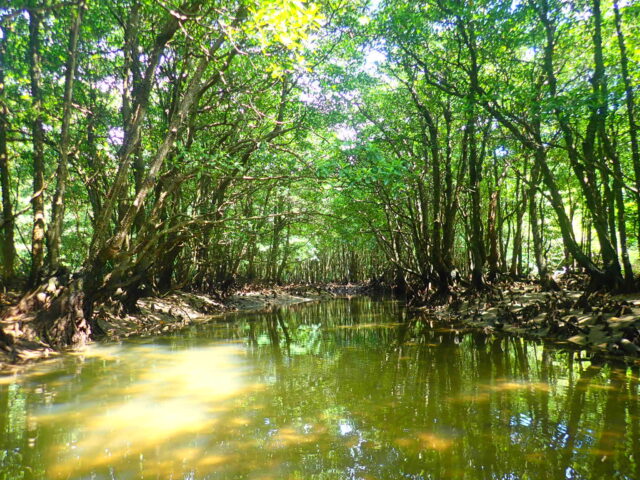
Iriomote Island is home to a wide variety of plants, but perhaps the most distinctive plants compared to other areas in Japan are the mangroves.
The size of the mangrove growing area in Iriomote Island is larger than any other place in Japan, and almost all species of mangroves that grow in Japan can be seen.
For example, the Nakama River watershed running south of Iriomote Island is said to have about 25% of Japan's mangrove area, making it the largest mangrove watershed area in Japan.
Mangroves grow near the mouths of most of the 40 or so rivers, large and small.
Thus, Iriomote Island is the best place to enjoy mangroves in Japan.
Where is Iriomote Island?
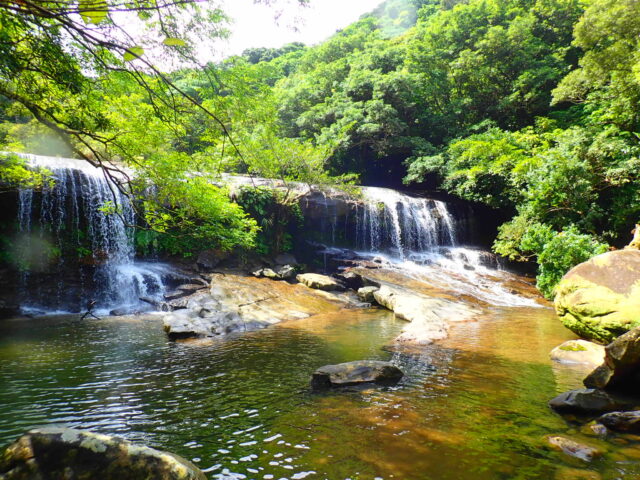
Iriomote Island, where mangroves grow, belongs to the Yaeyama Islands in Okinawa Prefecture, but is located closest to the southwest of Japan.
The distance from Tokyo is approximately 2,100 km.
Even from the main island of Okinawa, which is about 400 km away, the island is very close to Taiwan and is about 100 km east of Taiwan.
Geographically, it is 24 degrees north latitude and 123 degrees east longitude.
To get to Iriomote Island, you can take a boat from Ishigaki Island.
There are two ports on Iriomote Island, and the journey time is about 50 minutes if you take the general route.
About 90% of Iriomote Island is tropical rainforest
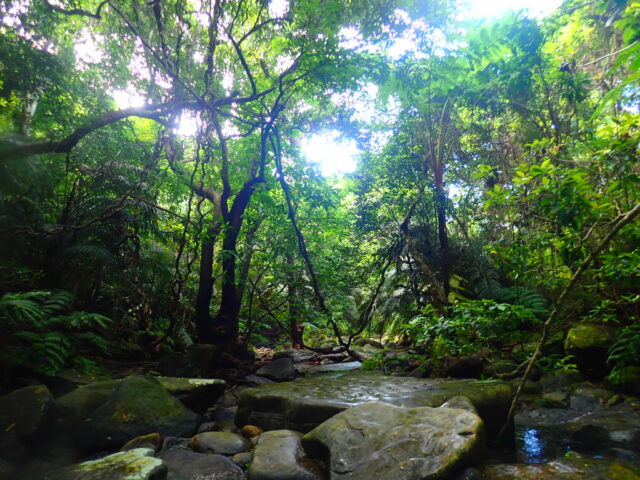
Iriomote Island belongs to a subtropical marine climate, with a temperature of about 18°C even in winter, and the average annual temperature is mild at about 23°C.
Being only 100 kilometers from the Tropic of Cancer, it is said to have a near-tropical, subtropical climate and natural environment.
Therefore, many tropical as well as subtropical plants grow on the island, and about 90% of the island would be said to be native subtropical and tropical forests.
Iriomote Island is home to a wide variety of native tropical plants, and the mangroves in this group of plants give the island a jungle-like atmosphere and allow visitors to enjoy activities that make use of them, thus greatly enhancing the tropical atmosphere of Iriomote Island.
Mangrove Ecology
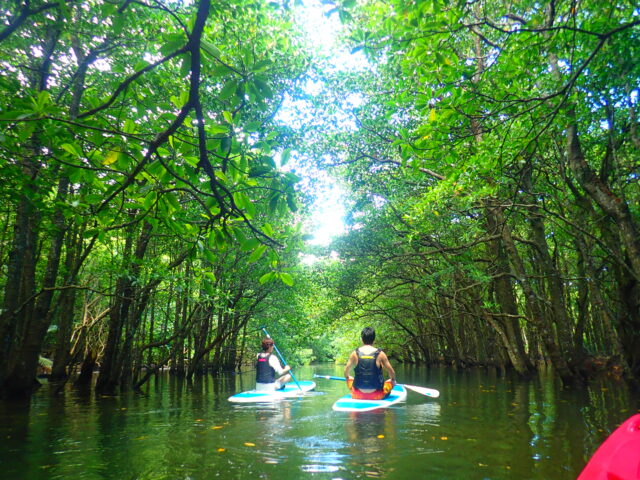
Here, we will introduce what kind of plants mangroves are, their ecology, and what kinds of mangroves grow on Iriomote Island.
In fact, there is no plant species named mangrove.
Mangroves are a general term for plants that grow in salt marshes where freshwater and seawater mix, such as on the coasts and at the mouths of rivers in tropical and subtropical regions.
Mangroves grow in what is called the intertidal zone.
The intertidal zone is the area affected by the ebb and flow of the tide.
In other words, at high tide, the area is hidden by the sea surface, and at low tide, the area is not submerged in sea water.
Because it grows in these locations, it appears to grow in the ocean at high tide.

The mangroves of Iriomote Island grow in the area between coral reefs formed in shallow water and plants growing completely on land, and together with coral reefs, they play an important role in shaping the ecosystem of Iriomote Island.
For example, at high tide, small fish can be seen congregating near the roots of the mangroves, providing a much-needed place for the creatures to gather on the roots.
The number of mangrove species growing in the world has not been fully determined, but it is estimated that there are approximately 110.
Roots are distinctive
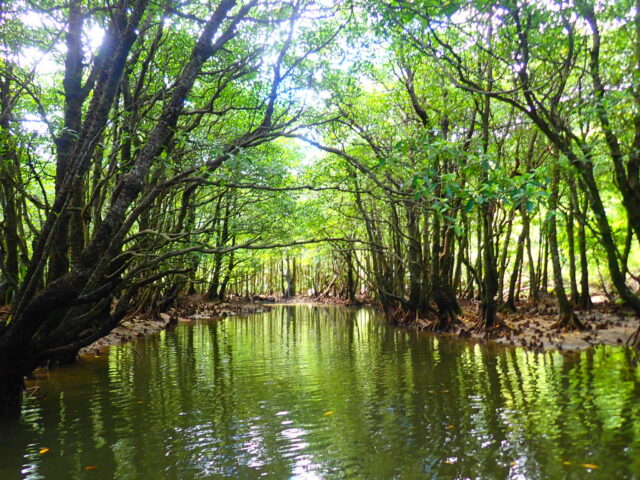
The most distinctive appearance of mangroves compared to other plants is their roots.
Since the growing environment is influenced by the tides, it is said to have formed distinctive roots in response to its environment.
For example, it will be said that mangrove roots have the ability to withstand even wind and tide, or not run out of acid even if they are under water at high tide.
There are four roots that are considered distinctive in their appearance
1. pillar root
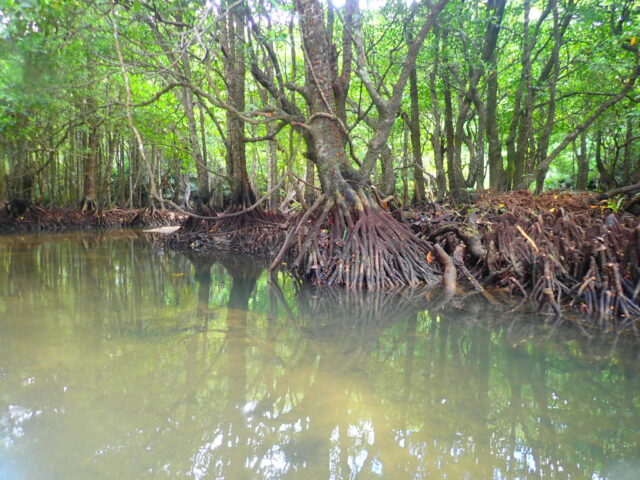
It is characterized by its octopus-like legs, which only members of the Yaeyama hirugi family possess.
It is often a large root, which gives it a sense of strength.
2. Knee root
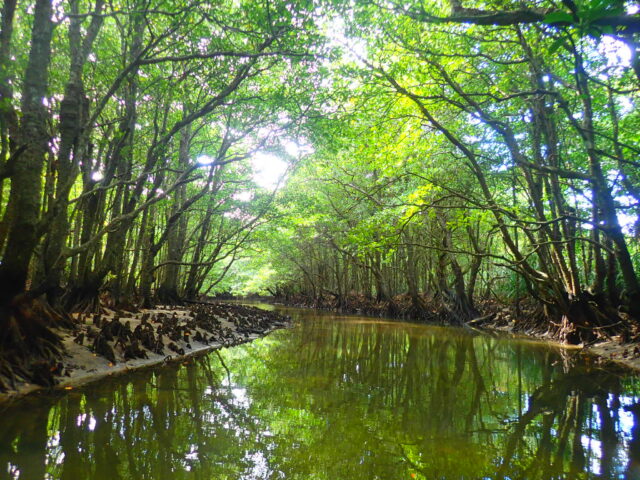
It is characterized by its shape, which resembles a person's bent knee, and is a root that is found only in the Ojirugi family.
3. bamboo shoot root
Named for its resemblance to bamboo shoots, this special root is capable of photosynthesis.
Because of its function, it is called a tsuki kikon or an erect tsuki kikon.
4. BANKON

Named for its plate-shaped roots, it is commonly found in mangroves in tropical rainforests.
Even though it is called a root, it has a history of being used as a material for wooden work such as daily utensils because of its large board shape, which was useful in daily life.
Types of Iriomote Island Mangroves
The following is a list of typical mangroves that grow on Iriomote Island.
Rhizophora mucronata (species of mangrove)

Yaeyama hirugi is written as "Yaeyama drifting tree.
This mangrove has prop roots to withstand waves and winds, and is salt-tolerant.
The splendid supporting roots are robust and powerful.
The trees are 4 to 8 meters tall.
black mangrove (Bruguiera gymnorrhiza)

It is said that because of its majestic appearance, it was considered a "male" hirugi, hence the name ohirugi.
Mangroves grow relatively close to land in the intertidal zone.
Since this is one of the largest groups of mangroves, all areas where it grows are characterized by the large size of the group.
The roots of the halibut have a shape called a knee-root, which extends above the ground.
The height of the tree is 5 to 10 meters high.
As shown in the photo, the flower is also distinctive, shaped like a red octopus sausage.
Kandelia obovata (species of mangrove)

It is said that it is considered a "female" hirugi because of its beautiful bonsai-like form and its neat, female-like appearance, hence the name "mehirugi" (meaning "female hirugi").
They are clustered on the landward side and will grow on sand flats and muddy wetlands.
The height of the tree is rather low, from 2 to 3 meters.
The flowers are white and beautiful.
white-throated spindle tree
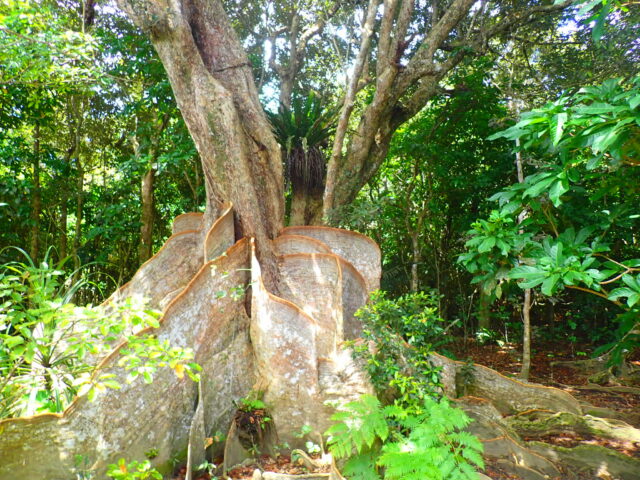
This plant grows in areas where a small amount of seawater flows in at high tide.
Its distinctive feature is its large plate root.
Large plank roots have a long history of being used to make ships and as wooden hoes.
As its name implies, saxifrage originated in the Sakishima Islands.
The oldest Saxifragaceae tree is located in the upper reaches of the Nakama River in Iriomote Island.
This place is also considered a power spot.
nipa palm
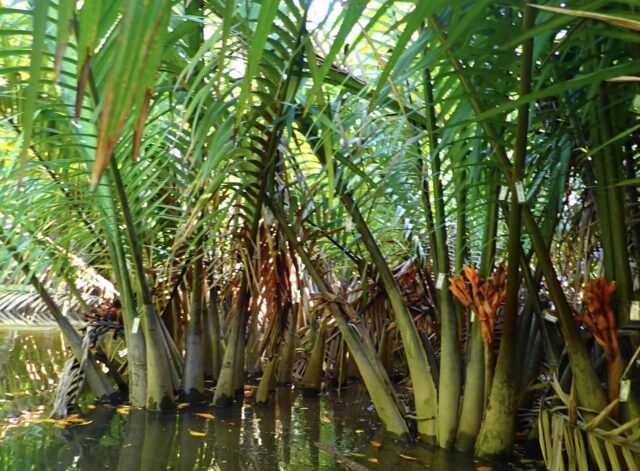
These mangroves grow in wetlands on the land side.
Beautiful bamboo-like leaves spread upward.
It is also characterized by bearing fruit that is made up of a tough shell and fibers.
It is a rare, stemless palm in Japan, and its trees are characterized by a rather low height of 2 to 4 meters.
summary
Iriomote Island is rich in pristine nature, where a wide variety of plants grow, about 90% of which are subtropical natives.
The many species of mangroves grow in this area, and the vast area in which they thrive dwarfs that of other areas in Japan.
Thus, Iriomote Island is the best place to enjoy mangroves.
What is distinctive about the appearance of mangroves is their roots.
There are four root forms, each with its own role in the growing environment.
The best way to fully enjoy the mangroves is to take a local tour.
Each activity offers a different way to enjoy the mangroves, so why not choose the tour that suits your mood at the time?

